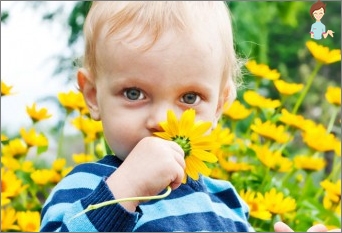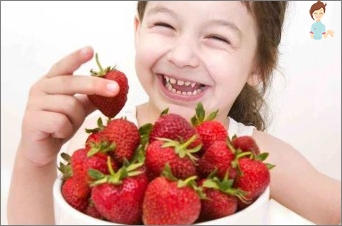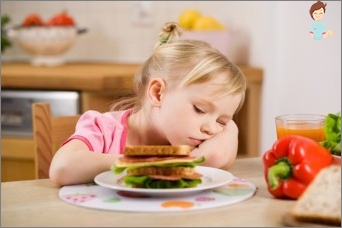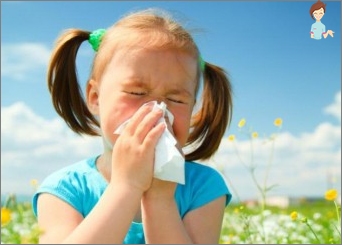Allergy in children
Signs of allergies in children at different ages. Food allergy. How to make a hypoallergenic diet. What ointments help from allergic rash
Allergies in different forms occurs every third child of preschool age. Special concern about the parents is allergic in breast babies, and this is quite explained, because the less age, the weaker the children’s body and the more thorough the selection of medicines and diet should be. At the same time, its symptoms are bright and noticeable from the first hours, which facilitates the definition and treatment of allergies in children.
Symptoms and types of allergies in children
Signs of allergies in children are the most diverse. As a rule, in the presence of several signs that make it possible to understand that it is precisely allergic symptoms. It is more difficult to suspect allergies to one of any sign, but this situation is rather rare.
Symptoms arise from the gastrointestinal tract, respiratory organs, skin cover and some other organs.
They show themselves as follows:
 Babies: Sustainable diameters, atopic dermatitis, urticaria, abdominal pain, intestinal colic, gases, constipation, diarrhea, vomiting, jumping;
Babies: Sustainable diameters, atopic dermatitis, urticaria, abdominal pain, intestinal colic, gases, constipation, diarrhea, vomiting, jumping;- in children of preschool and younger school age: atopic dermatitis, urticaria, abdominal pain, colic, gases, constipation, diarrhea, cyclical vomiting, allergic runny nose, very rarely – anaphylactic shock;
- Teenagers: Atopic dermatitis, Gastroenterocolon, irritable intestinal syndrome, stomatitis, conjunctivitis, allergic runny nose, edema throat, migraine, anaphylactic shock.
It is important to know that atopic dermatitis with red dry itching rashes arises from inhalation of dust, pollen, tobacco smoke, contact with pet hair, due to the transfer of a baby to artificial feeding or from hereditary predisposition.
Allergic runny nose with abundant discharge from the nose, difficult breathing, itching in the nose and eyes may also appear from mold in the house. And only food allergies in children are accompanied by a complex of gastrointestinal manifestations, rash, dizziness and sometimes cold.
Based on the main signs, immediately eliminate home sources of allergens and remove dangerous products from diet.
Food allergies
With the slightest suspicion, immediately exclude products from the list placed below. Allergy in an infant child means that the mother must refuse these products, because through milk from her body, allergens will fall in his stomach. Then the test of the baby should be examined by the doctor, making the blood test for immune responses.
To find out exactly what product has a reaction, it should be gradually entering one new product once every two or three days, watching and, if necessary, writing the result.
To effectively follow this scheme, you need to introduce a new product, take it from another group. This will help to avoid a cross-react – when an allergy from a child on a single product goes to other products from the same group.
Group of Food Allergens:
 Proteins of animal origin: milk, chicken eggs, fish, mussels, squid;
Proteins of animal origin: milk, chicken eggs, fish, mussels, squid;- Porridge: wheat (manna, Poltava, Artek), bias (pearl), corn, pshlin;
- Bean: beans, soybean, lentils, peas, peanuts;
- Umbrella: parsley, celery, carrots, onions;
- Polenic: Potatoes, Tomatoes, Eggplant, Sweet Pepper;
- Pumpkin: pumpkin, watermelon, melon;
- Citrus: Orange, Lemon, Mandarin, Grapefruit, Lime;
- Cruciferous: mustard, radish, horseradish;
- Composition: leaf salad;
- Heath: Cranberry, Lingonberry;
- Rose colored: strawberry, strawberries, apples (red), plums, apricots, peaches, almonds;
- Cocoa Oil.
Problems can cause artificial additives, caramel, starch, vinegar, citric acid, all kinds of peppers and spicy herbs, condensed milk and milk powder.
Basic diet with food allergies
Strictly observe a strict diet for a small child fraught with depletion, hypovitaminosis, loss of appetite. Therefore, it is extremely important to act according to the scheme, trying new products to add to the main hypoallergenic diet to find the maximum amount of safe products and have the ability to feed the baby nutritionally and diverse.
The most difficult in the diet with allergies in children is to exclude and replace the following products: Fresh solid milk, wheat dishes (porridge and bread), red and orange vegetables, fruits, berries, sugar, all fish and sea products, poultry meat, mushrooms , sausages, smoked.
Daily diet can be made up of neutral products if there is no individual intolerance to them.
Boiled veal and weak broth out of her. Rice and oatmeal are excellent with exacerbation of allergies, we can gradually give a buckwheat croup. In the absence of meteorism (gases), a slice of rye bread will be useful.

From vegetables – with caution potatoes, without restrictions peeled cucumbers, stewed zucchini, cabbage (except for red and broccoli). From greenery to salad you can add quite a bit dill.
Fruits are allowed in small quantities: apples without peel (only green varieties), carefully white grapes, pears. From berries You can try white currants, gooseberries, blueberries, silky, but only one type of berry in 2-3 days. Nuts are excluded.
Locked products can be seated – a small amount of low-fat kefir, yogurt or yogurt without sugar and taste additives. For a set of fats in the diet, you only need to use refined sunflower oil and fuel oil.
External drugs from allergies
Mazi for children from allergies help skin symptoms and are used in a complex with a diet, and if necessary with antihistamine or hormonal drugs. After analyzes at consultation, the doctor will appoint a specific ointment, which may be the only medicine in the fight against allergies.
With extreme caution should be treated with antibiotics oats: levosin, levomecol, fucidine, with erythromycin, gentamicin, lincomycin – as they themselves can become a new source of allergies.
Hormonal, or nonsteroid drugs – this is the second echelon of funds, when nothing else helps, and rash delivers the child of torment.
 All of them can be used only from 4 months, causing a thin layer on the skin.These are drugs such as Advantan, Eloc and Flutsinar.
All of them can be used only from 4 months, causing a thin layer on the skin.These are drugs such as Advantan, Eloc and Flutsinar.
With good results of a hypoallergenic diet, non-aggressive rash can be reduced by nonsteroidal ointments: Eliode, Bepanten and Moundahil. They shoot irritation, itching, burning, that give the child a long-awaited vacation and will help calm down. Also, the ointment contributes to the healing of cracks, guns and other changes on the skin, prevents combing and infection of possible wound.
Children’s allergy with adequate treatment, compliance with diet, healthy physical exertion, hygiene and a calm psychological situation around the child passes after 2-3 years without a trace, is preserved to adult rarely.


